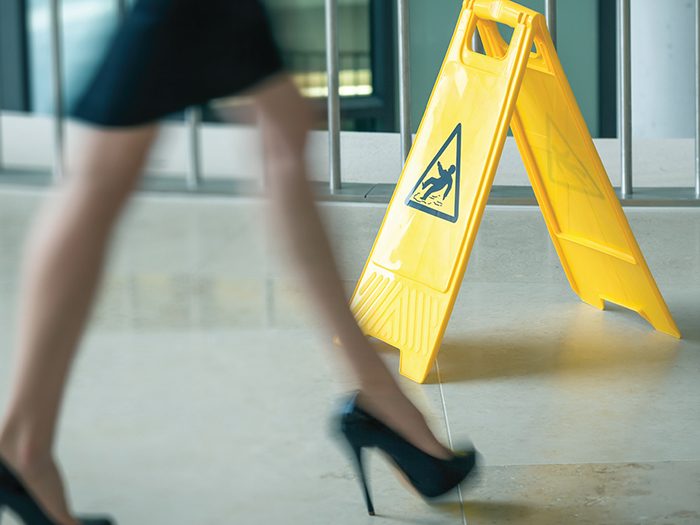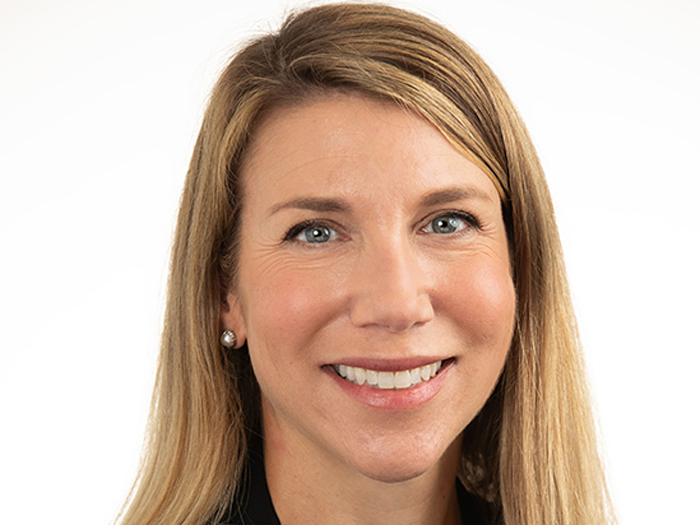Loss Prevention
How To Manage Losses Due To Slips and Falls in High-End Retail

Picture this: It’s the busy holiday shopping season. A mid-December snow, while charming and evocative of Christmas carols, brings moisture to the streets of New York, some of which is tracked into the foyer and shopping aisles of one of that city’s high-end retailers.
A shopper in her early seventies, well off but not as nimble as she once was, rounds the corner of one of the store’s aisles, which is more choked than usual with holiday sale displays and eye-catching impulse items.
She’s not in dressy high heels, but is wearing stylish leather boots with three-inch heels. Momentarily distracted, perhaps by the beauty of a glittering bulb on a real-life Christmas tree, or a nudge from a passing shopper, she steps on a slick point of the polished floor, made more slippery by those melted snowflakes. She slips, throws out her arm to catch something and catches nothing, striking the floor head first and suffering a traumatic brain injury.
This horrendous scenario, though not a frequent occurrence in high-end retail, does occur. And when it happens, it results not only in life-altering injuries but also settlements in the six figures. Employees are at risk as well. More than 17 percent of all disabling workplace injuries are caused by slips and falls.
Mitigating slips and falls in retail, in general, is complicated. But high-end retail, with its focus on heritage properties, original design materials and glossy finishes, carries its own set of risk management complications.
According to Walter Palmer, loss control expert and practice leader, EPIC Insurance Brokers & Consultants, high-end retail and its focus on design does present its own challenges; things such as marble staircases and vintage throw rugs aren’t a risk manager’s preferred materials.
“One of the challenges for risk managers is to have to work around those parameters the best they can so that they can support the artistic vision that the company has and at the same time be able to mitigate the risk. At high-end retail, they need to be able to tell that story to their broker,” he said.
I always tell my retail clients to take pictures right off the bat because you have one shot at that when a fall happens. Richard Gelok, Florida-based casualty general adjuster, Engle Martin
And although some high-end retailers shoot for a consistent look in their stores across the country, others may go for different styles, varying the layout from store to store, making the risk manager’s job that much harder.
High-end retailers also need to be very “buttoned down” about the way they report accidents. In the area of what claims adjusters call “frequent fliers,” or slip and fall fraudsters, Palmer’s high-end retail clients say they feel they are targeted by fraud perpetrators more often because of the perception they have deeper pockets and may also be more sensitive to the reputational hit of a casualty lawsuit.
Train and Document
Generally speaking, when it comes to the size of a claim, it matters more how severely injured a claimant is and how negligent the store owner was than the brand of the store. According to a veteran casualty claims adjuster, when an accident happens, documenting it well and handing the case off to the adjuster in good order is paramount.
“I always tell my retail clients to take pictures right off the bat because you have one shot at that when a fall happens,” said Richard Gelok, Florida-based casualty general adjuster, Engle Martin.
“I can come back 24 hours later after I get assigned the file and the scene is not going to be the same at all,” Gelok said. “It’s important to make an assessment of the claimant, if they’re smelling of alcohol, if they’re slurring their words, or if they were on their phone. There is comparative negligence with every slip and fall, in my opinion.”
“You’re going to have different defenses with respect to the defect that is being claimed,” said Kari Melkonian, a Michigan-based attorney of Collins, Einhorn, Farrell PC, who defends insureds and their insurance companies in slip-and-fall cases.
“Premises owners, in general, have a duty to protect invitees against known dangerous conditions on the property. Landlords owe additional statuatory duties to their tenants,” Melkonian said.
Videotaping store aisles can help a defendant if it can be shown that 90 people walked down a given aisle in one afternoon and only one of them fell and there was no evidence of water or any other hazard, she said.
Like Engle Martin’s Gelok, Melkonian said training employees to document the circumstances of the incident well, including taking photographs and interviewing the person that fell, are best practices.
Simple Chemistry
In 2010, commercial insurer CNA noticed an uptick in general liability claims involving slips and falls. The company set out to learn more about the topic and came up with some noteworthy conclusions.
In a two-year study of hard surface floors in commercial workplaces, CNA found that 50 percent of the surfaces studied did not meet the minimum traction standards set by the American National Standards Institute.
“From both the frequency and the severity standpoint, safety managers for these types of facilities aren’t always aware of the extent of their slip-and-fall exposure,” said Steve Hernandez, senior vice president of risk control, CNA.
CNA’s study authors came up with four key strategies to implement:
Select the right flooring. This includes not only the properties of the flooring itself, but also the space and the environment;
Test your floors for slip resistance. The science of tribometry measures slip resistance. This allows premises owners to better comply with flooring manufacturers’ specifications;
Choose the right cleaning agents: This one gets complicated. It involves insuring that cleaning vendors are not only using the right cleaning agents for the type of flooring they are cleaning, but that they are financially stable, ethically sound and operate under a strong risk management structure.
Even the way you store a mop matters, said CNA’s Hernandez. “The handle end should point down. Keeping the mop end on the floor means it’s always in contact with debris and won’t clear away contaminants as effectively;” and
Promote awareness of slip-and-fall hazards. This involves removing walkway obstacles, displaying signage in areas with floor elevation changes, placing mats near doorway entrances and using design that reduces reflective glare.
Falls among adults are the most common cause of traumatic brain injury. The CNA study reports that among its closed claims between 2007 and 2012, the average cost of a traumatic brain injury in a general liability claim was $269,643. The average cost of a traumatic brain injury in workers’ comp claims was $259,153.
EPIC’s Palmer said “underwriters are looking for good visibility and good reporting not just on the metrics as far as the final results, but also causality. They’re looking toward a comprehensive approach in terms of how you address it from a training perspective and the scientific aspect, making sure that you have corporately approved cleaning agents that work well in your environment.” &











